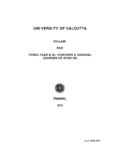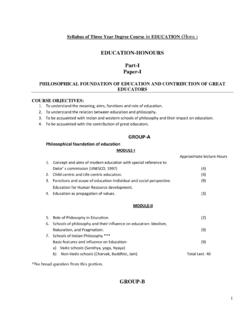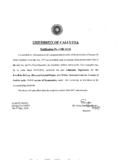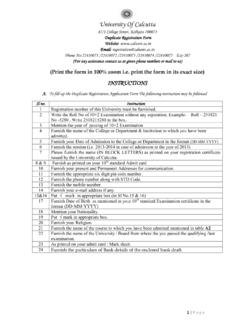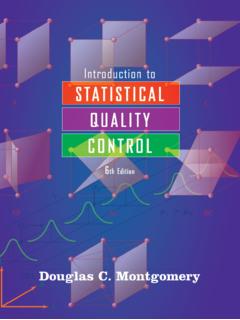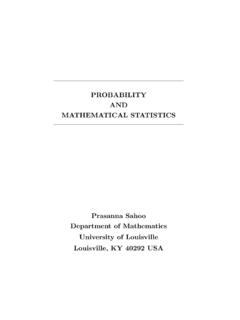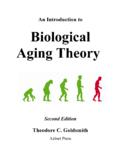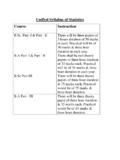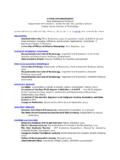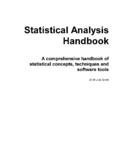Transcription of SYLLABI F O R THREE-YEAR B.Sc. HONOURS & GENERAL …
1 1 UNIVERSITY OF CALCUTTA SYLLABI F O R THREE-YEAR HONOURS & GENERAL COURSES OF STUDIES statistics 2010 2 UNIVERSITY OF CALCUTTA SYLLABI OF THE THREE-YEAR HONS. & GENERAL COURSES OF STUDIES IN statistics Course Structure ( statistics HONOURS ) for Annual System Part Paper Marks Topic (as mentioned in Year system) Topics from the modules Part 1 IA 50 Descriptive statistics Descriptive statistics I (101) Total 200 Descriptive statistics II (201) IB 50 Probability Theory I Probability Theory I (102) Probability Theory II (202) IIA 50 Linear Algebra and Population statistics Linear Algebra (103) Population statistics (203) IIB 50 Practical comprising of Papers IA,IB & IIA and use of spreadsheet (EXCEL) Practical including use of spreadsheet (EXCEL) (104 + 204) Part 2 IIIA 50 Mathematical Methods and Probability Theory II Mathematical Methods (301) Total 200 Probability Theory III (302) IIIB 50 Sampling Distributions and Statistical Inference I Sampling Distributions (401) Statistical Inference I (402)
2 IVA 50 Official & Economic statistics and Statistical Quality Control Official and Economic statistics (303) Statistical Quality Control (403) IVB 50 Practical comprising of Papers IIA,IIB &IIIA and use of MINITAB and C Practical including use of Statistical software : MINITAB and Programming Language: C (304 + 404) Part 3 VA 50 Multivariate Analysis and Large Sample Theory Multivariate Analysis (501) Total 400 Large Sample Theory (601) VB 50 Statistical Inference II Statistical Inference II (502) Statistical Inference III (602) VIA 50 Design of Experiments and Sample Survey Methods I introduction to Designs of Sample Survey and Experiment (503) Design of Experiments (603) VIB 50 Time Series Analysis and Sample Survey Methods II Time Series Analysis (504) Sample Survey Methods (604) VIIA 50 Practical comprising of Papers VA & VB 505 + 506 VIIB 50 Practical comprising of Papers VIA & VIB 605 + 606 VIIIA 50 Programming language C (selected features) Programming language C (selected features) I (507) Programming language C (selected features) II (508) VIIIB 50 Computation and Data Analysis Computation and Data Analysis I (607)
3 Computation and Data Analysis II (608) 3 HONOURS 101 Descriptive statistics I introduction : Nature of statistics , Uses of statistics , statistics in relation to other disciplines, Abuses of statistics . (2L) Types of Data: Concepts of population and sample, quantitative and qualitative data, cross-sectional and time-series data, discrete and continuous data, different types of scales. (3L) Collection of Scrutiny of Data: Primary data designing a questionnaire and a schedule, checking its consistency. Secondary data its major sources. Complete enumeration. Controlled experiments, Observational studies and Sample Surveys. Scrutiny of data for internal consistency and detection of errors in recording. Ideas of cross-validation. (3L) Presentation of data: Construction of Tables with one or more factors of classification, diagrammatic representations, frequency distributions and cumulative frequency distributions and their graphical representations, stem and leaf displays.
4 (4L) Univariate data different measures of location, dispersion, relative dispersion, skewness and kurtosis, Moments, Liaponouv s inequality, Quantiles and measures based on them comparison with moment measures. Box Plot. Outlier Detection. (13L) References : 1. Goon ,Gupta M. K., Dasgupta B.(1998): Fundamentals of statistics (V-1),World Press 2. Yule & Kendall (1950): An introduction to the Theory of statistics , 3. Snedecor & Cochran (1967): Statistical Methods (6th ed), Iowa State Univ. Press 4. Croxton , Cowden & Klein (1969): Applied GENERAL statistics , Prentice Hall 5. Wallis & Roberts (1957): statistics - a new approach, Methuen 6. Tukey (1977): Exploratory Data Analysis, Addison-Wesley Publishing Co.
5 102 Probability Theory I Random Experiment: Trial, Sample point, Sample space, Different types of events. (5L) Definition of probability: Classical and relative-frequency approach to probability, Kolmogorov s Axiomatic definition (detailed discussion on discrete space only), limitations of Classical definition. Probability of union and intersection of events, Probability of occurrence of exactly m and atleast m events out of n events. Conditional probability and Independence of events, Bayes Theorem and its applications. Examples based on classical approach and repeated trials (20L) References: 1. Chung (1983): Elementary Probability Theory with Stochastic Process, Springer / Narosa 2. Feller W. (1968): An introduction to Probability Theory & its Applications, John Wiley 3. Goon , Gupta & Dasgupta B.
6 (1994): An Outline of Statistical Theory (Vol-1), World Press 4. Rohatgi (1984): An Intro. to Probability Theory & Math. statistics , John Wiley 45. Hoel , Port & Stone ( ): introduction to Probability Theory (Vol-1), Mifflin & UBS 6. Cramer H. (1954): The Elements of Probability Theory, John Wiley 7. Parzen E. (1972): Modern Probability Theory and its Applications, John Wiley 8. Uspensky (1937): introduction to Mathematical Probability,McGraw Hill 9. Cacoullos T. (1973): Exercises in Probability. Narosa 10. Rahman (1983): Practical Exercises in Probability and statistics , Griffen 11. Pitman J. (1993): Probability, Narosa 12. Stirzaker D. (1994): Elementary Probability, Cambridge University Press 13. Chandra & Chatterjee D. (2001): A First Course in Probability, Narosa 14. Bhat (1999): Modern Probability Theory, New Age International 103 Linear Algebra Vector Algebra: Vector spaces with real field, Basis and dimension of a vector space, Orthogonal vectors, Gram-Schmidt Orthogonalization.
7 (7L) Matrix Algebra : Linear transformation and Matrices, Matrix operations, Elementary matrices and their uses, Rank of a matrix and related results, Inverse of a matrix, Determinants, the Sweep-out and the Pivotal Condensation methods, Characteristic roots and vectors , Quadratic forms classification and canonical reduction. (16L) Systems of Linear Equations: Homogeneous and Non-homogeneous systems conditions for solvability. (2L) References: 1. Hadley G. (1995): Linear Algebra, Addison Wesley/ Narosa 2. Rao & Bhimasankaran P. (1996): Linear Algebra 3. Searle (1982): Matrix Algebra useful for statistics , John Wiley 4. Rao (1974): Linear Statistical Inference & its Applications, Wiley Eastern 5. Hoffman K. & Kunze R. (2001): Linear Algebra 6.
8 Goon (1988): Vectors and Matrices 201 Descriptive statistics II Bivariate data scatter diagram, correlation coefficient and its properties, Correlation ratio, Correlation Index, Intraclass correlation, Concept of Regression, Principles of least squares, Fitting of polynomial and exponential curves. Rank correlation Spearman s and Kendall s measures. (17L) Analysis of Categorical Data: Consistency of data, independence and association of attributes, measures of association Pearson s and Yule s measures, Goodman-Kruskal s . Odds Ratio. Fitting of logit model through least squares. (8L) References : 1. Goon AM,Gupta MK,Dasgupta B.(1998):Fundamentals of statistics (V-1),World Press 2.
9 Yule & Kendall (1950): An introduction to the Theory of statistics , 3. Kendall & Stuart A. (1966): Advanced Theory of statistics (Vols 1 & 2) 4. Snedecor & Cochran (1967): Statistical Methods (6th ed), Iowa State Univ. Press 5. Croxton , Cowden & Klein (1969): Applied GENERAL statistics , Prentice Hall 56. Wallis & Roberts (1957): statistics - a new approach, Methuen 7. Lewis-Beck (edt.) (1993) : Regression Analysis, Sage Publications 8. (1984): Analysis of Ordinal Categorical Data 202 Probability Theory II Random Variables : Definition of discrete and continuous random variables, cumulative distribution function ( ) and its properties (with proof), probability mass function ( ) and probability density function ( ), Expectation and Moments, Dispersion, Skewness, Kurtosis, Quantiles (7L) The , and in bivariate case. Marginal and Conditional distributions, Independence, Conditional Expectation, Correlation and Regression.
10 Theorems on sum and product of expectations of random variables, (15L) Probability Inequalities: Markov s & Chebyshev s inequalities. (3L) References: 1. Chung (1983): Elementary Probability Theory with Stochastic Process, Springer / Narosa 2. Feller W. (1968): An introduction to Probability Theory & its Applications, John Wiley 3. Goon , Gupta & Dasgupta B. (1994): An Outline of Statistical Theory( Vol-1), World Press 4. Rohatgi (1984): An Intro. to Probability Theory & Math. statistics , John Wiley 5. Hoel , Port & Stone ( ): introduction to Probability Theory (Vol-1), Mifflin & UBS 6. Cramer H. (1954): The Elements of Probability Theory, John Wiley 7. Parzen E. (1972): Modern Probability Theory and its Applications, John Wiley 8. Uspesky (1937): introduction to Mathematical Probability,McGraw Hill 9. Cacoullos T. (1973): Exercises in Probability.
